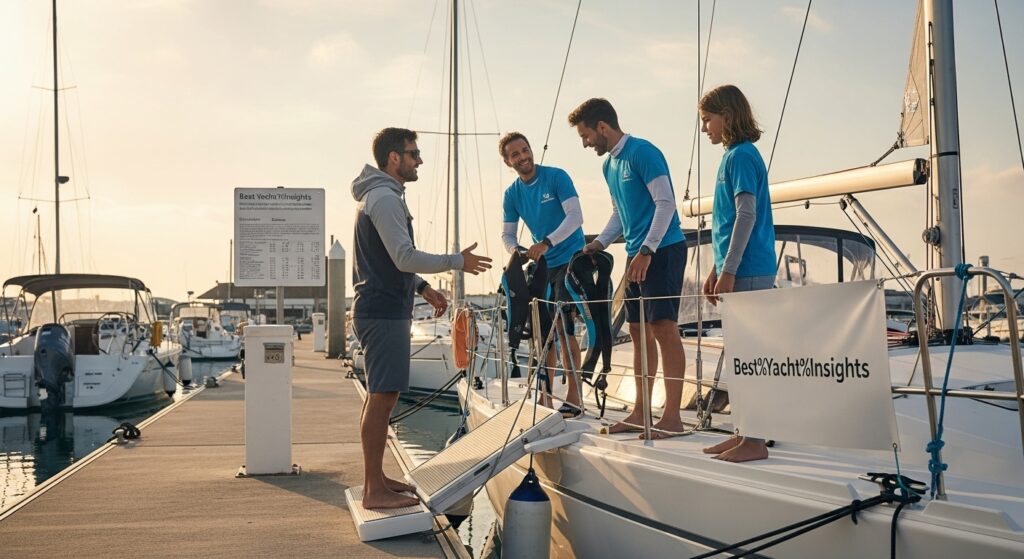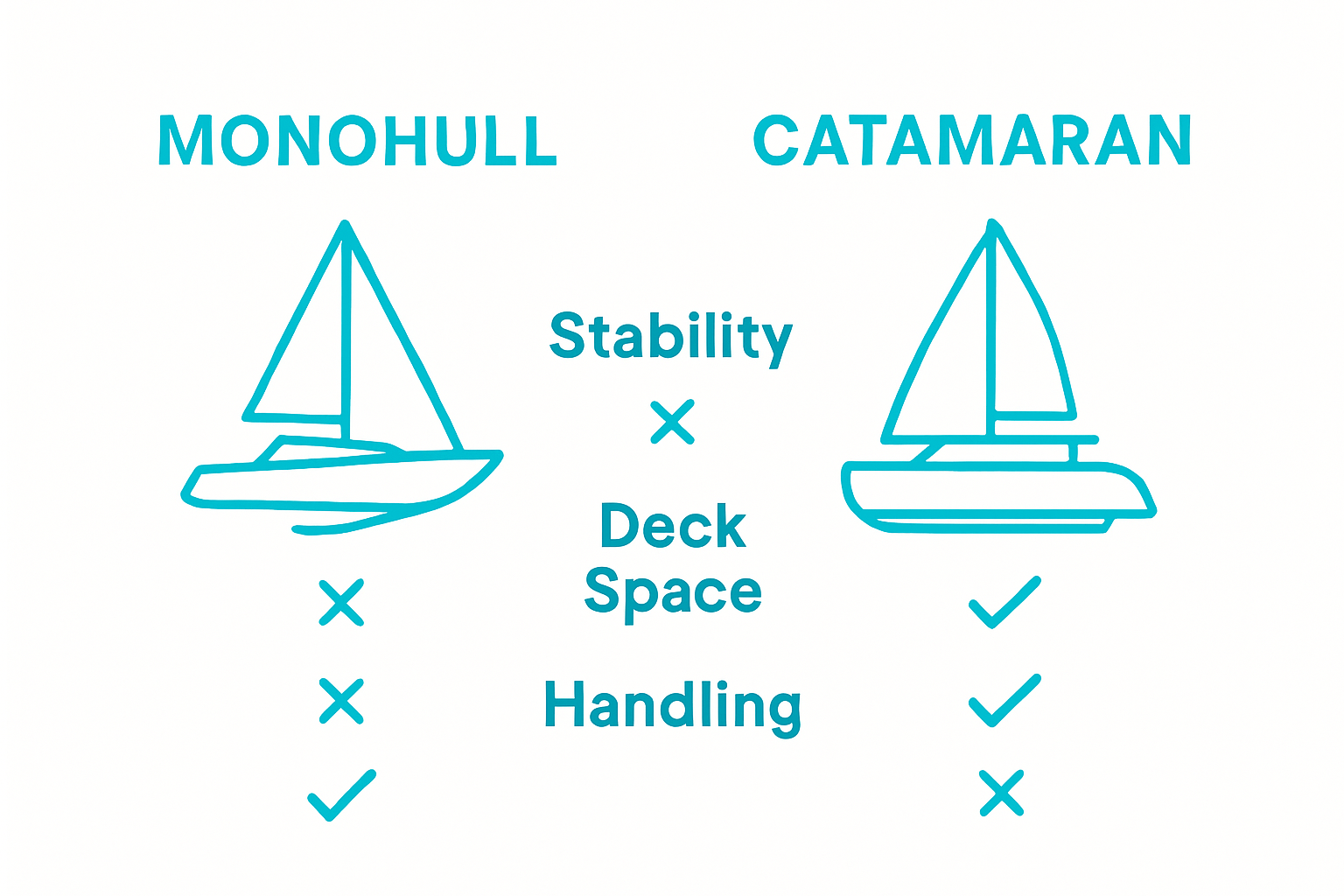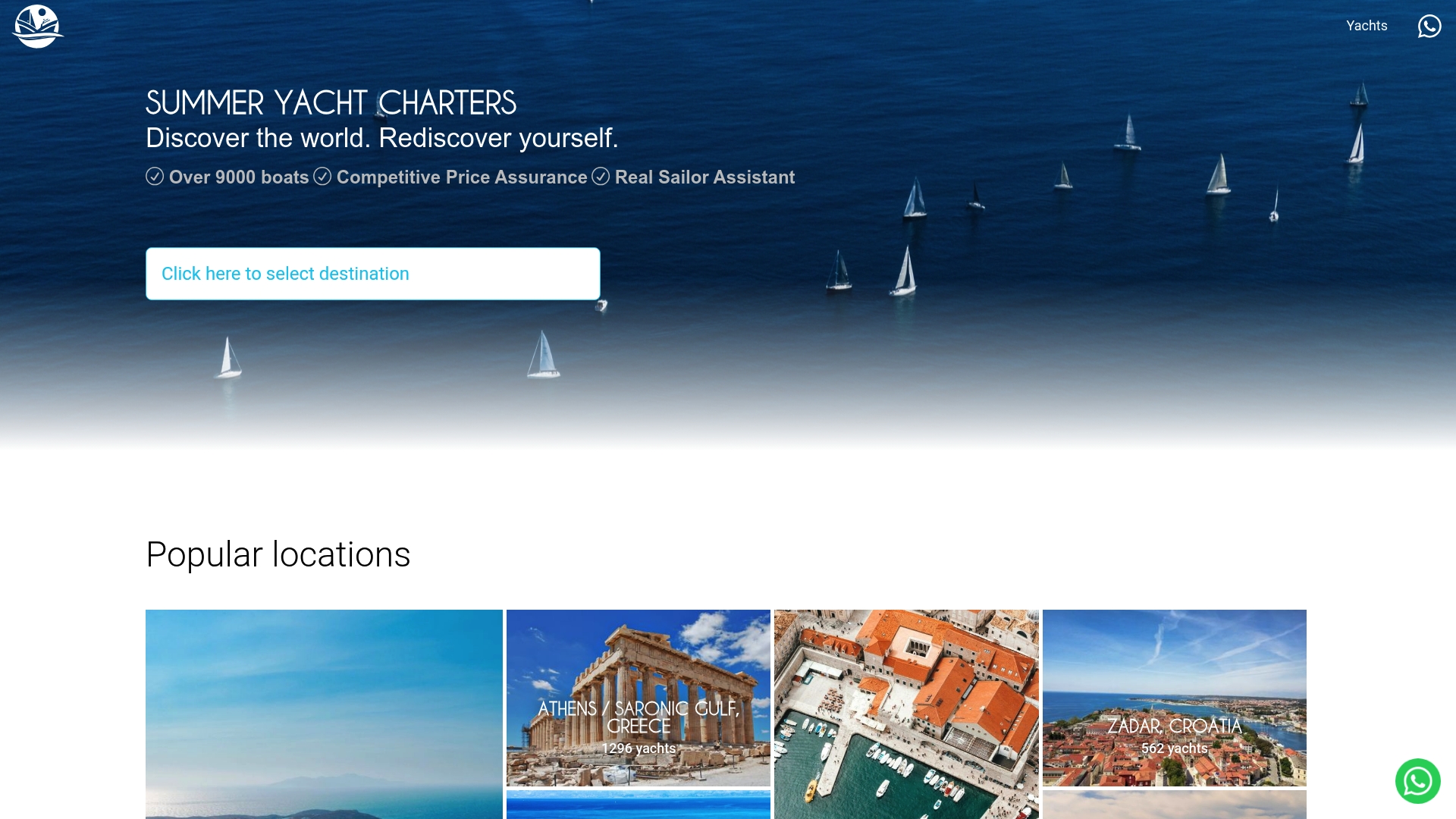Understanding the Best Yacht for Beginners: Key Insights
Explore the best yacht for beginners and gain a comprehensive understanding of features, benefits, and essential considerations for new sailors.

Choosing your first yacht can feel overwhelming, especially with so many options promising smooth sailing for new adventurers. Surprisingly, wider hull designs can improve beginner stability so much that catamarans are up to twice as stable as traditional monohulls, dramatically easing those first nerves. This means the best yacht for beginners is not always the one that looks sleekest or sails fastest. It is the one that quietly helps you learn, relax, and actually enjoy being on the water from day one.
Table of Contents
- What Defines The Best Yacht For Beginners?
- Essential Features Of Beginner-Friendly Yachts
- Why Choosing The Right Yacht Matters For New Sailors
- How Beginner Yachts Enhance The Learning Experience
- Real-World Examples Of Popular Beginner Yachts
Quick Summary
| Takeaway | Explanation |
| Choose stable hull designs | Stability is crucial for beginner yachts; opt for wider hulls for balanced sailing experiences. |
| Prioritize intuitive control systems | Simple and user-friendly rigs reduce complexity, helping novice sailors develop skills more easily. |
| Consider safety features | Look for yachts with self-draining cockpits and robust hulls for optimal safety while learning. |
| Select appropriate vessel size | A yacht size of 30-40 feet is ideal for beginners, providing manageability and comfort on the water. |
| Explore popular beginner yacht models | Research models like Beneteau First 24 or Lagoon 380 for proven performance and learning suitability. |
What Defines the Best Yacht for Beginners?
Selecting the best yacht for beginners requires understanding specific characteristics that make sailing accessible, enjoyable, and safe for newcomers to maritime adventures. The ideal beginner yacht is not just about size or appearance, but a combination of design, stability, ease of handling, and learning potential.
Essential Yacht Characteristics for Novice Sailors
The fundamental attributes that define an excellent yacht for beginners encompass several critical elements. Stability emerges as the primary consideration, with wider hull designs providing more balanced sailing experiences. Monohull or catamaran configurations each offer unique advantages for new sailors.
Key stability features include:
- Moderate displacement
- Wider beam (hull width)
- Balanced keel design
- Predictable handling characteristics
Navigation simplicity determines how comfortable a new sailor will feel controlling the vessel. Yachts with straightforward rigging, responsive steering, and intuitive control systems dramatically reduce the learning curve. Our comprehensive guide to boat rentals offers deeper insights into selecting beginner-friendly vessels.
Safety and Learning Potential
Safety represents another paramount factor when identifying the best yacht for beginners. According to research from the Royal Yachting Association, vessels with multiple safety features and predictable performance metrics provide optimal learning environments.
Ideal safety considerations include:
- Self-draining cockpits
- Robust hull construction
- Clear deck layouts
- Integrated safety equipment
- Simple capsize recovery mechanisms
Ultimately, the best yacht for beginners balances technical performance with user-friendly design, creating an inviting introduction to the fascinating world of sailing.
Essential Features of Beginner-Friendly Yachts
Navigating the maritime world requires understanding the specific yacht features that transform an intimidating vessel into an approachable learning platform. Beginner-friendly yachts are meticulously designed to provide confidence, safety, and an intuitive sailing experience for novice mariners.
Hull Design and Configuration
The yacht’s fundamental architecture plays a critical role in creating a stable and manageable sailing environment. Monohull and catamaran designs each present unique advantages for newcomers. Monohulls offer traditional sailing experiences with excellent responsiveness, while catamarans provide superior stability and spacious deck areas.
To clarify the differences between the two primary yacht types for beginners, the table below directly compares monohull and catamaran designs across core beginner-centric considerations.
| Feature | Monohull | Catamaran |
| Stability | Moderate; can heel significantly | High; up to twice as stable as monohull designs |
| Learning Curve | Traditional, responsive handling | Gentler, more forgiving for newcomers |
| Deck Space | More limited | Spacious deck areas |
| Comfort Underway | Increased rolling motion | Minimised rolling for comfort |
| Recovery from Capsize | More challenging | Typically easier, especially for smaller vessels |
| Psychological Impact | Can be intimidating when heeling | Instils confidence due to predictability |
| Example Beginner Models | Beneteau First 24, Hunter 27 | Lagoon 380, Bali 4.0 |

Key hull considerations include:
- Moderate length (between 30-40 feet)
- Wider beam for enhanced stability
- Balanced weight distribution
- Smooth hull surface for efficient movement
According to research from maritime engineering experts, hull design directly impacts a sailor’s initial learning curve and overall confidence on the water. Yacht Charter Tips for first-time guests provide additional insights into selecting the right vessel configuration.
Operational Simplicity and Control Systems
Beginner-friendly yachts prioritize intuitive control mechanisms that reduce complexity and minimize potential errors. User-friendly rigging, straightforward sail management, and responsive steering are paramount for new sailors developing their maritime skills.
Ideal control system features encompass:
- Simple, clearly labeled winches
- Ergonomic helm design
- Straightforward sail handling mechanisms
- Clear navigational instruments
- Predictable steering response
The goal is creating an environment where technical complexity does not overwhelm the learning process, allowing new sailors to build skills progressively and confidently.
The following table summarises the essential features that define a beginner-friendly yacht, providing a quick-reference guide to the most important attributes for those new to sailing.
| Feature Category | Key Beginner-Friendly Elements |
| Stability | Moderate displacement, wider beam, balanced keel |
| Safety | Self-draining cockpit, robust hull, clear deck layout |
| Control Systems | Simple rigging, ergonomic helm, straightforward sail management |
| Learning Support | Predictable handling, intuitive navigation instruments |
| Vessel Size | Ideally between 30-40 feet for manageability |
| Recovery Mechanisms | Easy capsize recovery, integrated safety equipment |
Ultimately, the most welcoming yacht for beginners combines technical sophistication with approachable design, transforming maritime exploration from an intimidating challenge into an exciting adventure.
Why Choosing the Right Yacht Matters for New Sailors
Selecting an appropriate yacht represents more than a simple purchasing decision – it is a critical foundation for a sailor’s learning journey, personal safety, and long-term maritime enjoyment. The vessel chosen can dramatically influence a newcomer’s confidence, skill development, and overall sailing experience.
Psychological Impact of Yacht Selection
Confidence and comfort emerge as fundamental psychological factors when selecting a beginner’s yacht. An overly complex or challenging vessel can intimidate new sailors, potentially deterring them from pursuing their maritime interests. Conversely, a well-matched yacht provides a nurturing environment that encourages skill progression and reduces performance anxiety.
Psychological considerations include:
- Intuitive control systems
- Predictable vessel behavior
- Manageable physical demands
- Opportunities for gradual skill building
- Minimal technical overwhelm
According to research from maritime training experts, the initial sailing experience significantly impacts long-term engagement with maritime activities. Learning to sail as an adult requires selecting a vessel that balances challenge with achievability.
Safety and Technical Compatibility
Beyond psychological factors, the right yacht ensures critical safety parameters. Technical compatibility between the sailor’s skill level and the vessel’s characteristics prevents potentially dangerous sailing scenarios. This alignment involves understanding navigation complexity, physical handling requirements, and potential environmental challenges.
Key safety considerations include:
- Appropriate size for skill level
- Stable hull design
- Reliable safety equipment
- Straightforward emergency protocols
- Predictable performance in varying conditions
The yacht serves as both a learning platform and a protective environment, transforming maritime exploration from a potentially intimidating experience into an accessible and enjoyable adventure. Selecting wisely means investing not just in a vessel, but in personal growth, skill development, and future maritime experiences.
How Beginner Yachts Enhance the Learning Experience
The right yacht serves as more than transportation – it functions as a dynamic educational platform that transforms complex maritime skills into accessible, enjoyable learning experiences. By carefully designing vessels with novice sailors in mind, manufacturers create environments that systematically build confidence and competence.
Progressive Skill Development
Learning architecture in beginner yachts focuses on creating intuitive pathways for skill acquisition. These vessels are engineered to provide immediate feedback, allowing new sailors to understand cause and effect in maritime navigation with minimal intimidation. The yacht becomes an interactive classroom where theoretical knowledge transforms into practical understanding.
Key skill development features include:
- Responsive steering mechanisms
- Clear visual navigation indicators
- Simplified sail management systems
- Forgiving hull designs
- Integrated learning support technologies
According to research from maritime training experts, progressive design encourages faster skill absorption. Smooth sailing for first-time charterers requires vessels that balance challenge with achievable learning curves.
Psychological Safety and Confidence Building
Beginner yachts transcend physical design by creating psychological safety zones that reduce performance anxiety. These vessels are deliberately crafted to minimize potential errors, providing new sailors with a sense of control and gradual mastery. The yacht becomes a supportive environment where mistakes are learning opportunities rather than sources of stress.
Confidence-building elements comprise:
- Predictable vessel responses
- Minimal complex technical requirements
- Ergonomic control layouts
- Stable performance characteristics
- Intuitive emergency management systems
Ultimately, an exceptional beginner yacht does more than transport sailors – it nurtures their maritime potential, transforming initial uncertainties into lifelong passion and expertise.
Real-World Examples of Popular Beginner Yachts
Transitioning from theoretical understanding to practical selection requires exploring specific yacht models that have proven successful for novice sailors. Understanding the characteristics of popular beginner yachts provides crucial insights into making an informed maritime investment.
Monohull Vessels for New Sailors
Monohull designs represent traditional sailing experiences offering exceptional responsiveness and learning opportunities. Several models stand out for their beginner-friendly attributes, providing stable platforms for skill development and maritime exploration.
Notable monohull recommendations include:
- Beneteau First 24
- Hunter 27
- Catalina 25
- J/22 Racer
- Jeanneau Sun Odyssey 349
According to research from maritime training experts, these vessels balance performance with approachability. The ultimate guide to choosing your perfect summer vessel offers comprehensive insights into vessel selection strategies.
Catamaran Options for Beginners
Catamaran configurations provide alternative learning platforms characterized by enhanced stability and spacious deck areas. These multi-hulled vessels offer unique advantages for sailors seeking comfortable, predictable maritime experiences.
Recommended catamaran models feature:
- Lagoon 380
- Fountaine Pajot Mahé 36
- Leopard 40
- Nautitech 40
- Bali 4.0
Catamarans excel in providing wider, more stable platforms that reduce initial sailing anxieties. Their design minimizes rolling motion, creating more comfortable environments for learning fundamental sailing techniques.
Selecting the ideal beginner yacht transcends technical specifications – it represents an investment in personal maritime growth, transforming nautical curiosity into lifelong passion and expertise.
Turn Key Insights Into Your Ideal First Sailing Holiday
Choosing the best yacht as a beginner is not just about the build or the brand. It is about gaining confidence, feeling secure, and finding a gentle entry into the world of yachting. If you have ever worried about complex controls, unpredictable handling, or the daunting process of picking the right starting point, you are not alone. Summer Yacht Charters understands these challenges. We offer not only a wide choice of handpicked beginner-friendly yachts but also clear guidance designed to match every novice sailor with the right vessel and sailing route. For inspiration on scenic and accessible journeys, explore our carefully compiled Sailing routes.

Take your first confident step onto the water with a team that personalises every detail, from route selection to vessel type. Visit Summer Yacht Charters to compare thousands of beginner-friendly yachts and let our experts help you build an unforgettable adventure. For tailored experiences and expert support, see our ITINERARIES and start planning your voyage today. Booking now ensures the best choice for the coming sailing season.
Frequently Asked Questions
What are the essential characteristics of a yacht for beginners?
The best yachts for beginners should be stable, with a wider hull design, moderate displacement, and predictable handling characteristics, providing a comfortable sailing experience.
How does hull design affect a beginner’s sailing experience?
Hull design plays a critical role in a beginner’s sailing journey. Monohulls offer responsiveness and traditional sailing experiences, while catamarans provide enhanced stability and spaciousness, making them safer and more manageable for new sailors.
What safety features should I look for in a beginner yacht?
Ideal safety features for beginner yachts include a robust hull, self-draining cockpits, clear deck layouts, integrated safety equipment, and easy recovery mechanisms to ensure a secure learning environment.
How can I enhance my sailing skills using a beginner yacht?
Beginner yachts are designed to facilitate progressive skill development by providing intuitive controls and responsive feedback. This allows new sailors to build confidence gradually and learn essential sailing techniques in a supportive environment.
Recommended
- Comprehensive Guide to Boat Rentals and Yacht Charters – Summer Yacht Charters
- Understanding Charter Boats: What Charter Boats Are – Summer Yacht Charters
- Yacht Charter Tips: 10 Things First-Time Guests Always Forget – Summer Yacht Charters
- Learning to Sail as an Adult: Your Complete Guide – Summer Yacht Charters
- Understanding the Importance of Boat Maintenance
- Master the Surfboard Stand Up: A Step-by-Step Guide – Surf Vida